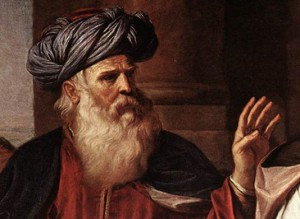The views expressed in our content reflect individual perspectives and do not represent the authoritative views of the Baha'i Faith.
After Abraham finished his altar-building work at the Moreh near Shechem, he moved to a new place and built a second altar at a site described in Genesis as being on the side of a mountain with Bethel to the west and Hai to the east.
Few historians and scholars agree about the probable location of this altar, largely due to the ambiguous nature of the descriptive terms: Bethel and Hai. Bethel means House of El, or House of God, but simply knowing the meaning of the word doesn’t help much.
During Abraham’s time in Canaan, numerous sites could have been referred to as a “bethel,” and each one would have had its own “house” or temple dedicated to Thoru-el, Baal, or another god. Abraham might have set up an altar near any one of them. Hai (also transliterated as Ai) is equally obscure because it basically means “heap” or “mass.” Some translators believe that it might have signified a specific ruin that was well-known to the Hebrews but lost to us now, while others believe it might point to a ruin that still exists but hasn’t been properly identified.
Another problem that must be faced when thinking about the location of Abraham’s second altar is the enigmatic nature of the Torah. The first five books of the Old Testament, including Genesis, were not handwritten by Moses, but they do spring directly from his revelation:
Know ye that the Torah is that which was revealed in the Tablets to Moses, may peace be upon Him, or that to which He was bidden. – Abdu’l-Baha, quoted in a letter written on behalf of the Universal House of Justice, March 13, 1986, in Hornby, Lights of Guidance, no. 1683.

Investigating the verses with appreciative eyes, we can now see the magnificent way Moses shaped the events of Abraham’s life into a dramatic narrative that transcends his earthly history.
At its most concrete level, the narrative in the Torah connects the followers of Moses to a noble ancestor named Abraham who walked where they walked and sacrificed his own comfort for their sakes. At its highest symbolic level, the verses are infused with mystical nuances and prophetic visions that have been a source of wonder, confusion, and delight for millennia.
Taking history, mysticism, and prophecy into consideration while simultaneously admitting the lack of physical evidence, one cannot be sure whether the altar between Bethel and Hai, or any Abrahamic altar mentioned by Moses, is tied to a certain latitude and longitude that existed in the past or whether it was intended to weave a connection between Abraham’s revelation and some future event.
The final bit of confusion about Abraham’s altars rises from wondering about the rationale behind each of the sites. Did he choose certain locations because of current conditions in his life, or did he seek out sites that would have importance in the future? Did he build them only for the convenience of his own followers, or to purposely puzzle the Canaanites? Is it possible that he chose them with full knowledge that several hundred years in the future, Moses would be able to visit the sites, point them out to the Israelites, and thus revive their weakening memories of Abraham? These wonderfully infuriating questions do not, alas, have irrefutable answers.
What we do know, with the clear hindsight given us by the passing of centuries, is that Canaan was the recipient of a majestic outpouring of mystical inspiration because:
Abraham’s migration from His native land caused the bountiful gifts of the All-Glorious to be made manifest… – Abdu’l-Baha, Selections from the Writings of Abdu’l-Baha, p. 280.

















Comments
Sign in or create an account
Continue with Facebookor